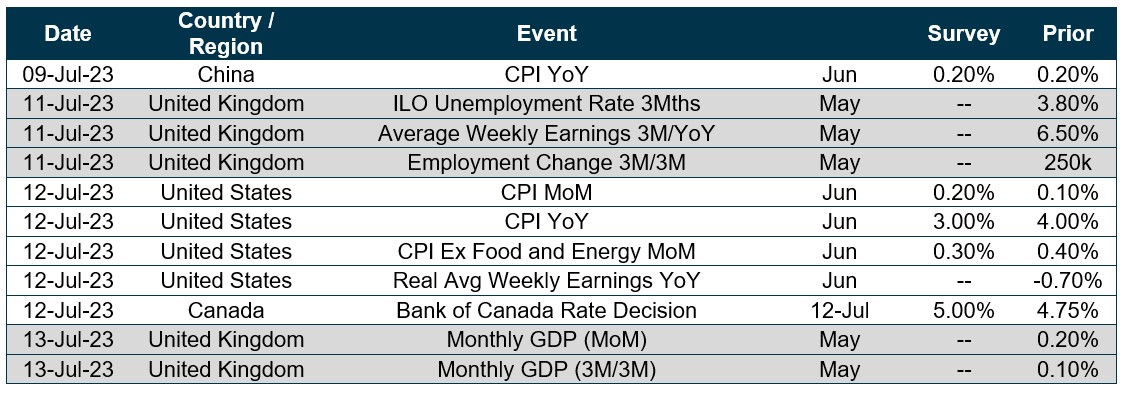Weekly Market Pulse - Week ending July 7, 2023
Market developments
Equities: U.S. stocks trimmed gains following mixed hiring data this week, the S&P 500 traded off recent highs with lower volume and closed the week down 1.15%, while the Nasdaq fell 0.90%. Investors are analyzing government jobs data that fell short of estimates on Friday, indicating cracks in the labour market but also highlighting wage inflation as a threat. The focus will shift to earnings season next week as we will begin to get Q2 earnings numbers as well as potential outlooks for the second half of the year.
Fixed income: Treasuries increased globally this week, the mixed performance in the U.S. as the short end of the curve remained relatively flat. The U.S. 2yr closed at 4.94%, while the U.S. 10yr jumped 22bps to 4.06%. U.S. inflation data is set to be released next week and traders are currently leaning towards the expectation of a rate hike at the upcoming Fed meeting. The Canadian 10yr also jumped this week, increasing 30bps to 3.57%.
Commodities: Oil prices rose for the second consecutive week as OPEC+ efforts to tighten supplies showed results. Saudi Arabia's price increases for its crude and an extension of supply cuts contributed to the surge in crude prices this week. Despite the strong week, oil is still down over 5% on the year.
Performance (price return)

As of July 7, 2023
Macro developments
Canada – Canada's June Unemployment Rate Reaches 5.4%
In June, Canada's unemployment rate rose to 5.4%, the highest since February 2022. However, it remains below pre-pandemic levels, highlighting a tight labour market. With 25.1 thousand more unemployed individuals, largely due to a larger labour force, the Canadian economy added 60 thousand jobs. Significant job gains were observed in wholesale and retail trade, manufacturing, and healthcare and social assistance, offsetting declines in construction and educational services.
U.S. – Unemployment Rate at 3.6% in June as Labour Market Remains Strong, Strong Growth in U.S. Services Sector
In June 2023, the U.S. unemployment rate held steady at 3.6%, in line with market expectations and lower than the previous month's high of 3.7%. The number of unemployed individuals decreased by 140,000, while employment levels rose by 273,000. The U.S. labour market remains tight, allowing the Federal Reserve to potentially continue raising interest rates.
In June, the ISM Services PMI surged to 53.9, marking the strongest growth in the services sector in four months. Key factors driving this growth include accelerated production, new orders, and rebounding employment. Price pressures eased, supplier deliveries improved, and inventories rose for the second consecutive month. While cautious about inflation and the economic outlook, respondents reported stable business conditions.
International – Eurozone Retail Sales Remain Unchanged in May
Eurozone retail sales showed no change for the second consecutive month in May, failing to meet expectations of a 0.2% increase. Persistently high inflation and rising borrowing costs constrained household incomes, resulting in stagnation. Sales of food, drinks, tobacco, and automotive fuel declined, while spending on non-food items saw a slight increase. On a yearly basis, retail trade contracted for the eighth consecutive month, dropping by 2.9% in May.
Quick look ahead

As of July 7, 2023
